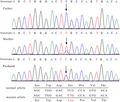- Record: found
- Abstract: found
- Article: found
A heterozygous point mutation of the ANKRD11 (c.2579C>T) in a Chinese patient with idiopathic short stature

Read this article at
Abstract
Background
Pathogenic variants of ANKRD11 have been reported to cause KBG syndrome characterized by short stature, characteristic facial appearance, intellectual disability, macrodontia, and skeletal anomalies. However, the direct clinical relevance of ANKRD11 mutation with short stature is yet unknown.
Methods
Here, we report a Chinese boy with idiopathic short stature (ISS) based on clinical and genetic characteristics. Comprehensive medical evaluations were performed including metabolic studies, endocrine function tests, bone X‐rays, and echocardiography. Whole‐exome and Sanger sequencing was used to detect and confirm genetic mutations associated with short stature in this patient, respectively. The pathogenicity of the variant was further predicted by several in silico prediction tools and repositories of sequence variation. Twenty‐four months follow‐up was performed to observe the growth rate of the patient treated with recombinant human growth hormone (GH).
Results
One heterozygous point mutation (c.2579C>T) was confirmed in the ANKRD11 gene of the patient and inherited from his mother. This mutation site was located within the highly conservative region of ANKRD11 protein and predicted to be possibly damaging in several in silico prediction programs and repositories of sequence variation. Additionally, patient underwent GH replacement therapy for 24 months exhibited good response to the treatment.
Abstract
Here, we report a Chinese boy with idiopathic short stature based on clinical and genetic characteristics. One heterozygous point mutation (c.2579C>T) was confirmed in the ANKRD11 gene of the patient and inherited from his mother. This is the first report of a Chinese idiopathic short stature patient with a point mutation of the ANKRD11 gene,the patient was treated effectively with growth hormone supplementation.
Related collections
Most cited references19
- Record: found
- Abstract: found
- Article: not found
Mutations in ANKRD11 cause KBG syndrome, characterized by intellectual disability, skeletal malformations, and macrodontia.
- Record: found
- Abstract: found
- Article: not found
Ankrd11 is a chromatin regulator involved in autism that is essential for neural development.
- Record: found
- Abstract: found
- Article: not found
